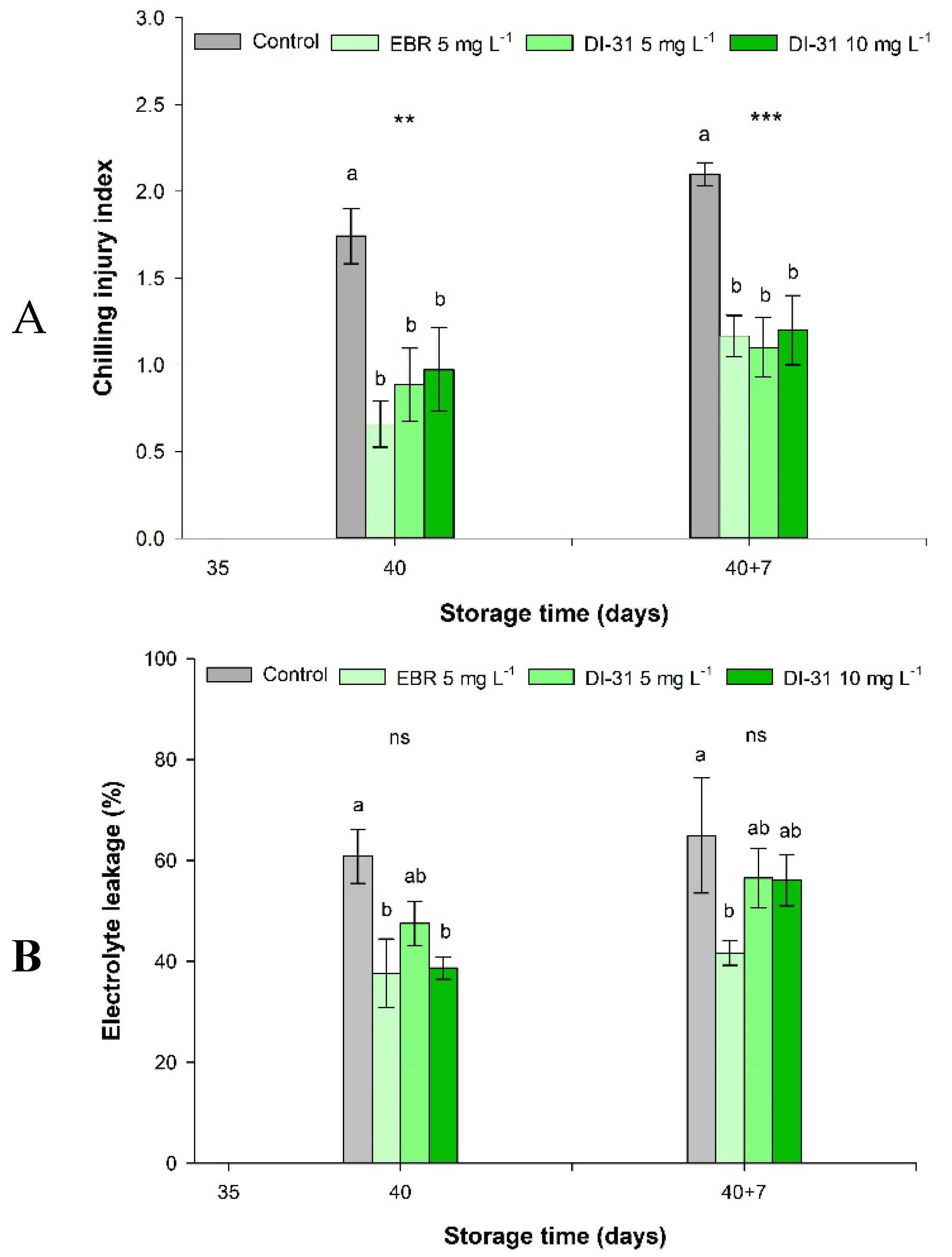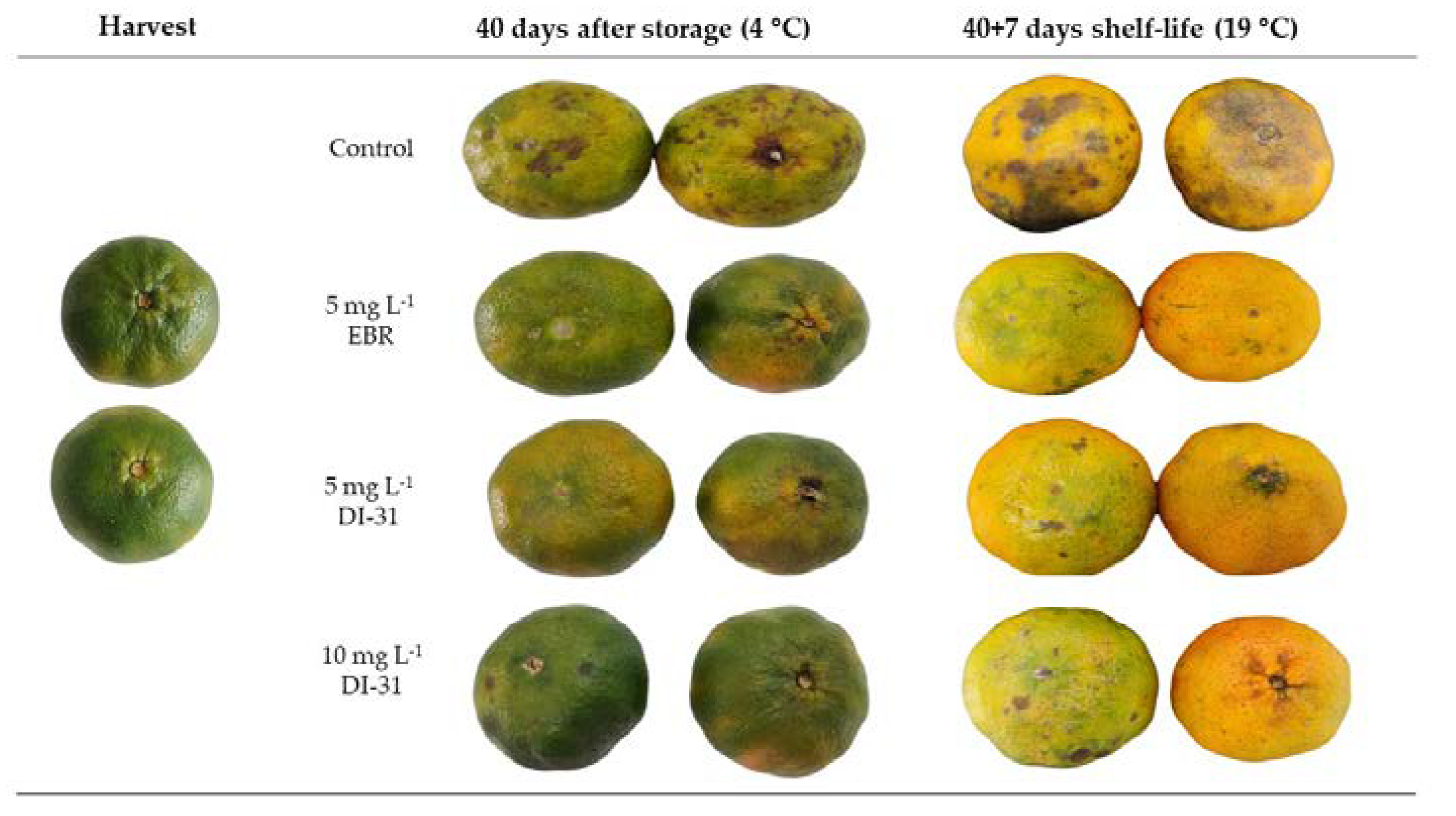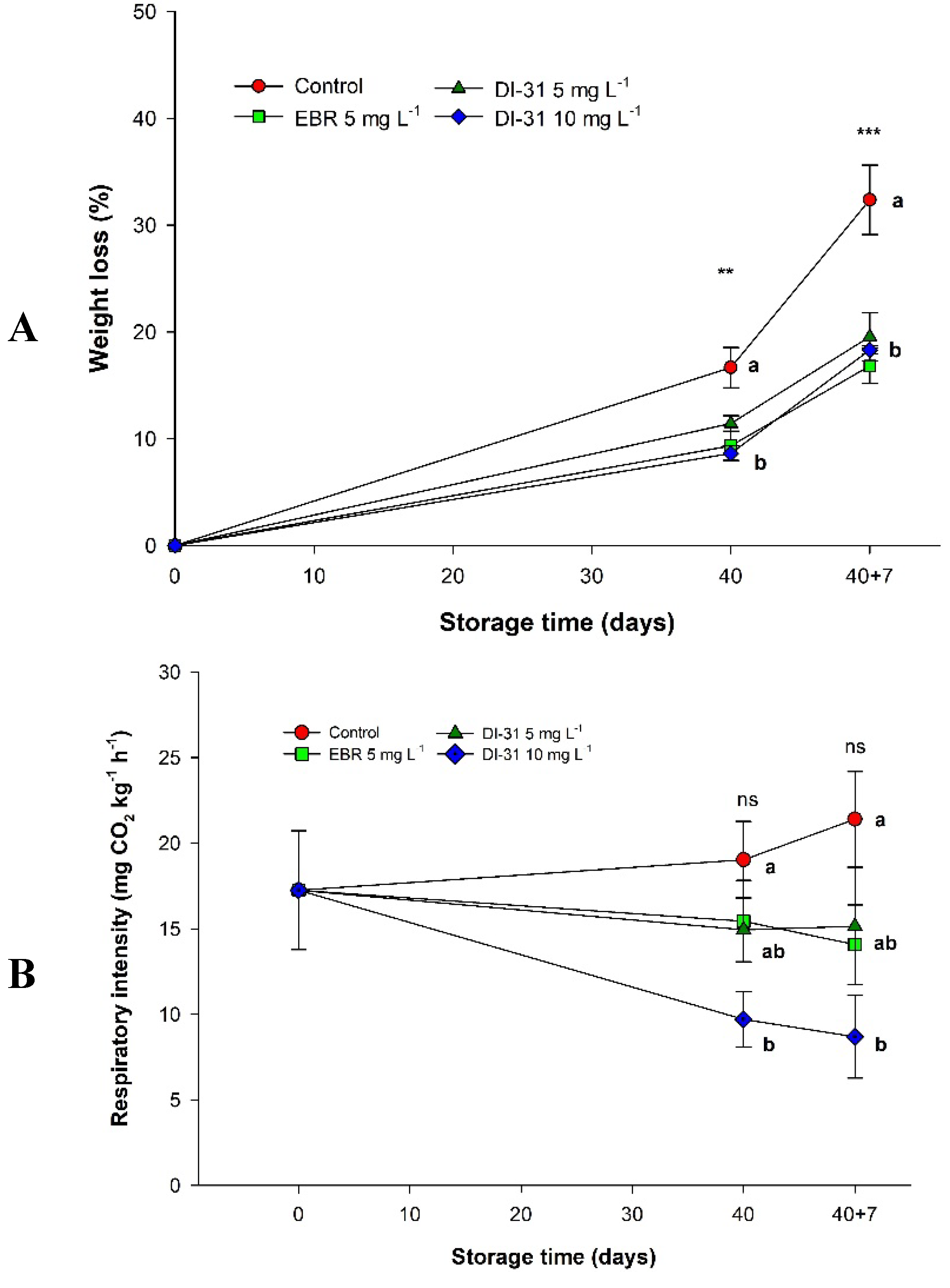Submitted:
06 May 2023
Posted:
08 May 2023
You are already at the latest version
Abstract
Keywords:
1. Introduction
2. Materials and Methods
2.1. Plant Material Treatments and Storage Conditions
2.2. Evaluation of Chilling Injury Index and Electrolyte Leakage
2.3. Determination of Physicochemical Properties
2.4. Estimation of Weight Loss and Respiratory Intensity
2.5. Quantifying Pigments and Color Index
2.6. Antioxidant Activity and Total Phenolic Content
2.7. Statistical Analysis
3. Results
3.1. Chilling Injury Index and Electrolyte Leakage
3.2. Firmness, Soluble Solids, and Titratable Acidity
3.3. Weight Loss and Respiratory Intensity
3.4. Pigments and Color Index
3.5. Antioxidant Activity and Phenolic Content
4. Discussion
5. Conclusions
Author Contributions
Data Availability Statement
Acknowledgments
Conflicts of Interest
References
- Ordúz-Rodríguez, J.O. , Monroy J.; Barrera, S.; Núñez, V.; Ligarreto, G.A. Caracterización morfo-agronómica y molecular de mandarina ‘Arrayana’ en el piedemonte del Meta (Colombia). Corpoica Cienc. Tecnol. Agropecu. 2012, 13, 5–12. [Google Scholar] [CrossRef]
- Balaguera-López, H. E. , Ortega, E. A. P., Consuegra, S. A. L. Effects of thermal treatments on chilling injury and shelf life time of Citrus reticulata Blanco. Pesqui Agropecu. Trop. 2019, 49, e56821. [Google Scholar] [CrossRef]
- Ladaniya, M. Citrus Fruit: Biology, Technology and Evaluation, 2nd ed.; Academic Press: San Diego, CA, USA, 2022. [Google Scholar] [CrossRef]
- Lado, J. , P., Rodrigo, M., Zacarías, L. (2019). Chilling Injury. In Postharvest Physiological Disorders in Fruits and Vegetables; Tonetto de Freitas, S., Pareek, S., Eds.; CRC Press: Nueva York, NY, USA, 2019. [Google Scholar] [CrossRef]
- Strano, M. C., Altieri, G., Allegra, M., Di Renzo, G. C., Paterna, G., Matera, A., & Genovese, F. Postharvest Technologies of Fresh Citrus Fruit: Advances and Recent Developments for Loss Reduction during Handling and Storage. Horticulturae 2022, 8, 612. [CrossRef]
- Lafuente, M.; Zacarías, L.; Sala, J.; Sánchez-Ballesta, M.T.; Gosalbes, M.; Marcos, J.; González-Candelas, L.; Lluch, Y.; Granell, A. Understanding the basis of chilling injury in citrus fruit. Acta Hortic. 2005, 682, 831–842. [Google Scholar] [CrossRef]
- Zacarias, L.; Cronje, P.J.; Palou, L. Postharvest technology of citrus fruits. In The Genus Citrus; Talon, M., Caruso, M., Gmitter, F.G., Jr., *!!! REPLACE !!!*, Eds.; Woodhead Publishing: Sawston, UK, 2020; pp. 421–446. [Google Scholar] [CrossRef]
- Chalutz, E.; Waks, J.; Schiffmann-Nadel, M. A comparison of the response of different citrus fruit cultivars to storage temperature. Sci Hortic. 1985, 25, 271–277. [Google Scholar] [CrossRef]
- Balaguera-López, H. E.; Palacios, O. Comportamiento poscosecha de frutos de mandarina (Citrus reticulata Blanco) var. Arrayana: efecto de diferentes tratamientos térmicos. Rev. Colomb. Cienc. Hortic., 2018, 12, 369–378. [Google Scholar] [CrossRef]
- Albornoz, K.; Zhou, S.; Yu, J.; Beckles, D. Dissecting postharvest chilling injury through biotechnology. Curr. Opin. Biotechnol. 2022, 78, 102790. [Google Scholar] [CrossRef]
- Valenzuela, J.; Manzano, S.; Palma, F.; Carvajal, F.; Garrido, D.; Jamilena, M. Oxidative Stress Associated with Chilling Injury in Immature Fruit: Postharvest Technological and Biotechnological Solutions. Int. J. Cell. Sci. Mol. Biol. 2017, 18, 1467. [Google Scholar] [CrossRef]
- Serna-Escolano, V.; Martínez-Romero, D.; Giménez, M.J.; Serrano, M.; García-Martínez, S.; Valero, D.; Valverde, J.M.; Zapata, P.J. Enhancing antioxidant systems by preharvest treatments with methyl jasmonate and salicylic acid leads to maintain lemon quality during cold storage. Food Chem. 2021, 338, 128044. [Google Scholar] [CrossRef]
- Rey, F.; Zacarías, L.; Rodrigo, M. J. Carotenoids, Vitamin C, and Antioxidant Capacity in the Peel of Mandarin Fruit in Relation to the Susceptibility to Chilling Injury during Postharvest Cold Storage. Antioxidants 2020, 9, 1296. [Google Scholar] [CrossRef]
- Taiz, L.; Zeiger, E.; Møller, I.M.; Murphy, A. Fundamentals of Plant Physiology, 6th ed; Sinauer Associates: New York, NY, USA, 2018. [Google Scholar]
- Hussain, M.A.; Fahad, S.; Sharif, R.; Jan, M.F.; Mujtaba, M.; Ali, Q.; Ahmad, A.; Ahmad, H.; Amin, N.; Ajayo, B.S. Multifunctional role of brassinosteroid and its analogues in plants. Plant. Growth Regul. 2020, 92, 141–156. [Google Scholar] [CrossRef]
- Cáceres, J. L.; Eduard, D.A.; Cortés, M. C.; Balaguera-López, H. E. Role of brassinosteroids in fruit trees with emphasis on abiotic stress conditions: A review. Ciencia y Agricultura 2022, 19, 132–147. [Google Scholar] [CrossRef]
- Tanveer, M.; Shahzad, B.; Sharma, A.; Khan, E.A. 24-Epibrassinolide application in plants: An implication for improving drought stress tolerance in plants. Plant Physiol. Biochem. 2018, 135, 295–303. [Google Scholar] [CrossRef]
- Zullo, M.A.T.; Bajguz, A. The brassinosteroids family–structural diversity of natural compounds and their precursors. In Brassinosteroids: Plant Growth and Development; Hayat, S., Yusuf, M., Bhardwaj, R., Bajguz, A., Eds.; Springer: Singapore, 2019; pp. 1–44. [Google Scholar] [CrossRef]
- Duran, M.I.; González, C.; Acosta, A.; Olea, A.F.; Díaz, K.; Espinoza, L. Synthesis of Five Known Brassinosteroid Analogs from Hyodeoxycholic Acid and Their Activities as Plant-Growth Regulators. Int. J. Mol. Sci. 2017, 18, 516. [Google Scholar] [CrossRef]
- Rivera, D.G.; Leon, F.; Coll, F.; Davison, G.P. Novel 5β-hydroxyspirostan-6-ones ecdysteroid antagonists: Synthesis and biological testing. Steroids 2006, 71, 1–11. [Google Scholar] [CrossRef]
- Ji, Y., Qu, Y., Jiang, Z., Yan, J., Chu, J., Xu, M., Su., X., Yuan, H., Wang, A. (2021). The mechanism for brassinosteroids suppressing climacteric fruit ripening. Plant Physiology, 185(4): 1875–1893. [CrossRef]
- Vergara A.E.; Díaz K.; Carvajal R.; Espinoza L.; Alcalde J.A.; Pérez-Donoso A.G. Exogenous Applications of Brassinosteroids Improve Color of Red Table Grape (Vitis vinifera L. Cv. “Redglobe”) Berries. Front. Plant Sci. 2018, 9, 363. 9. [CrossRef]
- Zhu, F.; Yun, Z.; Ma, Q.; Gong, Q.; Zeng, Y.; Xu, J.; Cheng, Y.; Deng, X. Effects of exogenous 24-epibrassinolide treatment on postharvest quality and resistance of Satsuma mandarin (Citrus unshiu). Postharvest Biol. Technol. 2015, 100, 8–15. [Google Scholar] [CrossRef]
- Chai, Y.; Zhang, Q.; Tian, L.; Li, C.; Xing, Y.; Qin, L.; Shen, Y. Brassinosteroid is involved in strawberry fruit ripening. Plant Growth Regul. 2013, 69, 63–69. [Google Scholar] [CrossRef]
- Habibi, F.; Serrano, M.; Zacarías, L.; Valero, D.; Guillén, F. Postharvest Application of 24-Epibrassinolide Reduces Chilling Injury Symptoms and Enhances Bioactive Compounds Content and Antioxidant Activity of Blood Orange Fruit. Front. Plant Sci. 2021, 12, 12. [Google Scholar] [CrossRef]
- Tavallali, V. Vacuum infiltration of 24-epibrassinolide delays chlorophyll degradation and maintains quality of lime during cold storage. Acta Sci Pol- Hortoru. 2018, 17, 35–48. [Google Scholar] [CrossRef]
- Gao, H.; Zhang, Z.; Lv, X.; Cheng, N.; Peng, B.; Cao, W. Effect of 24-epibrassinolide on chilling injury of peach fruit in relation to phenolic and proline metabolisms. Post. Biol. Technol. 2016, 111, 390–397. [Google Scholar] [CrossRef]
- Islam, M.; Ali, S.; Nawaz, A.; Naz, S.; Ejaz, S.; Shah, A. A.; Razzaq, K. Postharvest 24-epibrassinolide treatment alleviates pomegranate fruit chilling injury by regulating proline metabolism and antioxidant activities. Postharvest Biol. Technol. 2022, 188, 111906. [Google Scholar] [CrossRef]
- Massolo, J. F.; Sánchez, R.; Zaro, M. J.; Concellón, A.; Vicente, A. R. Low-dose prestorage 24-epibrassinolide spray enhances postharvest chilling tolerance in zucchini squash (Cucurbita pepo L.) by eliciting peroxidase and phenolic antioxidants. J. Food Process. Preserv. 2022, 46, e16576. [Google Scholar] [CrossRef]
- Wang, Q.; Ding, T.; Gao, L.; Pang, J.; Yang, N. Effect of brassinolide on chilling injury of green bell pepper in storage. Sci. Hortic. 2012, 144, 195–200. [Google Scholar] [CrossRef]
- Wang, Y.; Luo, Z.; Huang, X.; Yang, K.; Gao, S.; Du, R. Effect of exogenous g-aminobutyric acid (GABA) treatment on chilling injury and antioxidant capacity in banana peel. Sci. Hortic. 2014, 168, 132–137. [Google Scholar] [CrossRef]
- Gómez, C. A.; Herrera, A. O.; Flórez, V. J. Efecto de 1-metilciclopropeno y temperatura de almacenamiento en la poscosecha de mandarina (Citrus reticulata L.) var. Arrayana. Rev. Fac. Cienc. Agrar. 2015, 47, 27–41. [Google Scholar]
- Wellburn, A. R. The spectral determination of chlorophyll a and b, as well as total carotenoids, using various solvents with spectrophotometers of different resolution. Plant Physiol. 1994, 144, 307–313. [Google Scholar] [CrossRef]
- González, A.K.; L.F., González-Martínez; L.D., Córdoba; A., Rincón; H. E., Balaguera-López. Regulating the postharvest life of Campomanesia lineatifolia R. & P. fruits through the interaction of ethylene, 1-methylcyclopropene and low temperatures. Rev. Colomb. Cienc. Hortic. 2021, 15, e12499. [CrossRef]
- Tesfay, S.Z.; Bertling, I.; Bower, J.P. Effects of postharvest potassium silicate application on phenolics and other antioxidant systems aligned to avocado fruit quality. Postharvest Biol. Technol. 2011, 60, 92–99. [Google Scholar] [CrossRef]
- Grijalva-Verdugo, C.; Rodríguez-Núñez, J. R.; Núñez-Colin, C. A.; Aguirre-Mancilla, C. L.; Montoya-Anaya, D.; Villareal-Fuentes, J. M.; Balois-Morales, R.; Rodríguez-Carrillo, M. G. Total polyphenolic, antioxidants, and cytotoxic activity of infusions from soursop (Annona muricata) leaves from two Mexican regions. Agron. Colomb. 2022, 40, 300–310. [Google Scholar] [CrossRef]
- Singleton, V.L.; Rossi, J.A. Colorimetry of total phenolics with phosphomolybdic-phosphotungstic acid reagents. Am. J. Enol. Vitic. 1965, 16, 144–158. [Google Scholar] [CrossRef]
- Tian, J.; Xie, S.; Zhang, P.; Wang, Q.; Li, J.; Xu, X. Attenuation of postharvest peel browning and chilling injury of banana fruit by Astragalus polysaccharides. Postharvest Biol. Technol. 2022, 184, 111783. [Google Scholar] [CrossRef]
- Hatsugai, N.; Katagiri, F. Quantification of plant cell death by electrolyte leakage assay. Bio-Protocol 2018, 8, e2758. [Google Scholar] [CrossRef]
- Gao, H.; Kang, L.; Liu, Q.; Cheng, N.; Wang, B.; Cao, W. Effect of 24-epibrassinolide treatment on the metabolism of eggplant fruits in relation to development of pulp browning under chilling stress. J. Food Sci. Technol. 2015, 52, 3394–3401. [Google Scholar] [CrossRef] [PubMed]
- Lado, J.; Rodrigo, M.J.; Zacarías, L. Analysis of ethylene biosynthesis and perception during postharvest cold storage of Marsh and Star Ruby grapefruits. Food Sci. Technol. Int. 2015, 21, 537–546. [Google Scholar] [CrossRef] [PubMed]
- Cohen, E.; Shapiro, B.; Shalom, Y.; Klein, J.D. Water Loss: A Nondestructive Indicator of Enhanced Cell Membrane Permeability of Chilling-injured Citrus Fruit. J. Am. Soc. Hortic. Sci. 1994, 119, 983–986. [Google Scholar] [CrossRef]
- EL-Eryan, E.E. Improving tommy atkins mango resistance to chilling injury during cold storage and marketing. J. Plant Prod. 2020, 11, 563–573. [Google Scholar] [CrossRef]
- Brownleader, M.; Jackson, P.; Mobasheri, A.; Pantelides, A.; Sumar, S.; Trevan, M.; Dey, P. Molecular aspects of cell wall modifications during fruit ripening. Crit. Rev. Food Sci. 1999, 39, 149–164. [Google Scholar] [CrossRef] [PubMed]
- Pakkish, Z.; Ghorbani, B.; Najafzadeh, R. Fruit quality and shelf life improvement of grape cv. Rish Baba using Brassinosteroid during cold storage. J. Food Meas. Charact. 2019, 13, 967–975. [Google Scholar] [CrossRef]
- Rodrigo, M.J.; Alquézar, B.; Alós, E.; Lado, J.; Zacarías, L. Biochemical bases and molecular regulation of pigmentation in the peel of Citrus fruit. Sci. Hortic. 2013, 163, 46–62. [Google Scholar] [CrossRef]
- Liu, L.; Chengguo, J.; Min, Z.; Delong, C.; Sixue, C.; Rongfang, G.; Deping, G.; Qiaomei, W. Ectopic expression of a BZR1–1D transcription factor in brassinosteroid signalling enhances carotenoid accumulation and fruit quality attributes in tomato. Plant Biotechnol. J. 2014, 12, 105–115. [Google Scholar] [CrossRef]
- Li, T.; Yun, Z.; Wu, Q.; Zhang, Z.; Liu, S.; Shi, X.; Duan, X.; Jiang, Y. Proteomic profiling of 24-epibrassinolide-induced chilling tolerance in harvested banana fruit. J. Proteomics 2018, 187, 1–12. [Google Scholar] [CrossRef]
- Hu, S.; Wang, T.; Shao, Z.; Meng, F.; Chen, H.; Wang, Q.; Zheng, J.; Liu, L. Brassinosteroid Biosynthetic Gene SlCYP90B3 Alleviates Chilling Injury of Tomato (Solanum lycopersicum) Fruits during Cold Storage. Antioxidants 2022, 11, 115. [Google Scholar] [CrossRef]





| Parameter | Value |
| Firmness (N) | 24.16 ± 1.28 |
| Titratable acidity (%) | 1.34 ± 0.41 |
| Total soluble solid (°Brix) | 9.14 ± 0.55 |
| Respiratory intensity (mg CO2 kg-1 h-1) | 17.25 ± 4.75 |
| Color index | -12.12 ± 2.51 |
| Chlorophyll a (mg g-1 FW) | 0.26 ± 0.02 |
| Chlorophyll b (mg g-1 FW) | 0.147 ± 0.06 |
| Total chlorophyll (mg g-1 FW) | 0.548 ± 0.04 |
| β-carotene (µg g-1) | 728.20 ± 76.99 |
| Antioxidant activity (mM TEAC) | 1.00 ± 0.10 |
| DPPH scavenging capacity (%) | 43.05 ± 7.06 |
| Total phenolic content (mg GA g-1 FW) | 32.45 ± 6.73 |
| Treatments | Days | Firmness (N) |
TTA (% of citric acid) |
TSS (°Brix) |
| Control | 40 | 22.98 ± 0.87 aA | 0.84 ± 0.10 aA | 9.48 ± 0.32 aA |
| 40+7 | 20.64 ± 7.50 aA | 1.07 ± 0.40 aA | 8.90 ± 0.40 abB | |
| EBR (5 mg L-1) | 40 | 18.62 ± 3.92 bA | 0.81 ± 0.15 aA | 9.20 ± 0.40 aA |
| 40+7 | 22.80 ± 2.88 aA | 0.90 ± 0.45 aA | 9.54 ± 0.45 aA | |
| DI-31 (5 mg L-1) | 40 | 16.45 ± 1.88 bA | 0.81 ± 0.18 aA | 9.26 ± 0.31 aA |
| 40+7 | 21.30 ± 6.03 aA | 0.83 ± 0.68 aA | 8.94 ± 0.68 abA | |
| DI-31 (10 mg L-1) | 40 | 15.81 ± 0.70 bB | 0.83 ± 0.18 aA | 8.52 ± 0.38 bA |
| 40+7 | 22.27 ± 4.09 aA | 0.96 ± 0.90 aA | 7.80 ± 0.90 bA |
| Treatments | Days | Chl a (mg g-1) | Chl b (mg g-1) | Total Chl (mg g-1) | β-carotene (µg g-1) | Color index |
| Control | 40 | 0.28 ± 0.02 aA | 0.112 ± 0.01 aA | 0.56 ± 0.02 abA | 1110.1 ± 57.6 bA | -9.09 ± 1.33 aA |
| 40+7 | 0.06 ± 0.01 aB | 0.026 ± 0.01 aB | 0.12 ± 0.04 aB | 822.9 ± 56.4 aB | -0.83 ± 1.05 aB | |
| EBR (5 mg L-1) |
40 | 0.20 ± 0.03 aA | 0.076 ± 0.04 aA | 0.39 ± 0.02 bA | 1150.1 ± 26.4 bA | -10.23 ± 1.04 aA |
| 40+7 | 0.03 ± 0.01 aB | 0.026 ± 0.01 aB | 0.07 ± 0.02 aB | 980.3 ± 62.1 aA | -0.81 ± 0.68 aB | |
| DI-31 (5 mg L-1) |
40 | 0.31 ± 0.01 aA | 0.140 ± 0.05 aA | 0.62 ± 0.02 aA | 1357.7 ± 38.2 aA | -10.05 ± 0.69 aA |
| 40+7 | 0.04 ± 0.01 aB | 0.023 ± 0.01 aB | 0.09 ± 0.02 aB | 1072.6 ± 75.8 aB | 0.68 ± 0.91 aB | |
| DI-31 (10 mg L-1) |
40 | 0.24 ± 0.03 aA | 0.087 ± 0.03 aA | 0.47 ± 0.02 abA | 1174.4 ± 89.9 bA | -8.54 ± 1.49 aA |
| 40+7 | 0.05 ± 0.01 aB | 0.033 ± 0.01 aB | 0.11 ± 0.03 aB | 1004.6 ±119 aA | -0.46 ± 1.03 aB |
Disclaimer/Publisher’s Note: The statements, opinions and data contained in all publications are solely those of the individual author(s) and contributor(s) and not of MDPI and/or the editor(s). MDPI and/or the editor(s) disclaim responsibility for any injury to people or property resulting from any ideas, methods, instructions or products referred to in the content. |
© 2023 by the authors. Licensee MDPI, Basel, Switzerland. This article is an open access article distributed under the terms and conditions of the Creative Commons Attribution (CC BY) license (http://creativecommons.org/licenses/by/4.0/).





